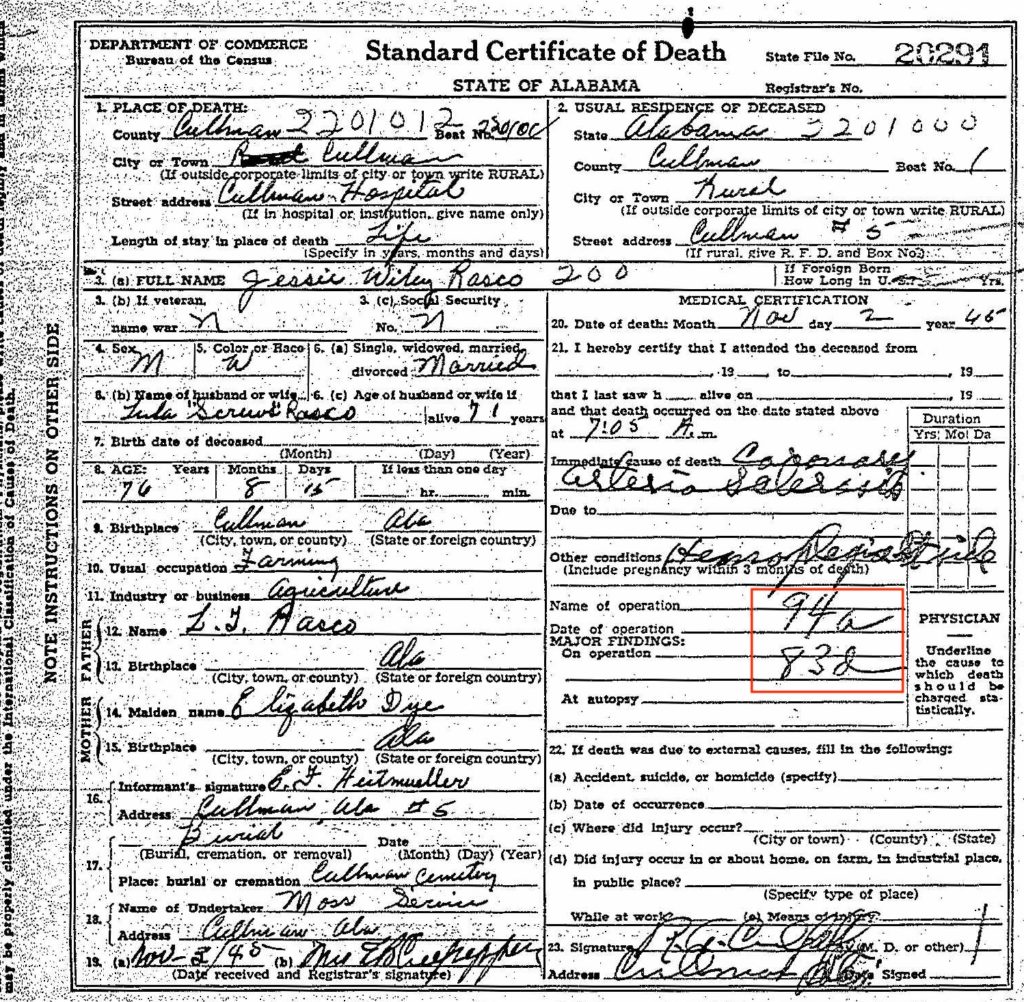Today, I was processing a death certificate for a collateral relative (thank you, 30 x 30 challenge!) and as I squinted at the cause of death I thought it said pneumonia. But I wasn’t sure. I didn’t know if I should risk a wrong assumption and decided to check the ICD code. I did a quick google search to see if I could find what that ICD code 92 would have represented in 1929 and didn’t come up with an easy answer. And then I remembered I’d blogged about it. So I looked on my blog and found the post, from May 1, 2020, which contains a link to the International Classifications of Diseases page at Wolfbane. That got me thinking that re-running my 2020 post about ICD codes might help my readers. So here it is again, in its entirety. P.S. 92 did indicate pneumonia in 1929!
Death certificates can provide such great information, which is why I always try to track them down. Often my eye makes a bee-line for the names of the parents of the deceased, but of course there’s much more information to be found. One area, cause of death, is always of interest. Unfortunately, that information seems to often be the most illegible. In the past, if I could make out the words I would add them to my database. But if I couldn’t, I’d just move along.
But I’ve learned that with a little more effort you can decipher the cause of death and learn more about your ancestor. Often, in addition to the written-out words describing cause of death, there’s a ICD (International Classification of Diseases) code as well. If you can’t read the words, you can look up the ICD code to get more information. Just visit the International Classification of Diseases page at Wolfbane.com to track down the meaning of the code.
Let’s use a death certificate from my great grandfather’s brother, Jesse Wiley Rasco (1978-1957), to illustrate this.
Here’s his 1945 death certificate. I’ve put a red border around the ICD codes.
As you can see, the ICD code for the primary cause of death is 94a. And the ICD code for the secondary cause of death is 83d. I could read the words for the primary cause of death. To me, it looks like Coronary Arteriosclerosis. Ordinarily, I would have stopped there. But the secondary cause of death was hard to decipher and I was curious.
I went to the International Classification of Disease page at Wolfbane.com and clicked on ILCD Revision 5 (1938), which would have been the version in use in 1945, since the next revision came out in 1948. The codes are listed in numerical order, so it was easy for me to find 94a, “diseases of the coronary arteries.” The secondary cause of death, 83d, is “hemiplegia and other paralyses of unstated origin.” Once I read that, I could see the word hemiplegia in the handwriting. It’s hard to make out the word after, but it looks to me like it could be “stroke.” I looked up the word hemiplegia and learned that it means “Paralysis on one side of the body.” [Edited to add: I received a note from reader Dennis Young suggesting that the handwriting says “Rt. side.” That makes complete sense and now seems obvious! The plot thickened a little when I received a note from reader Brad Pierce suggesting that the words say Lt. side, not Rt. side. Brad’s a physician himself so is probably good at deciphering doctor’s handwriting! I can’t tell whether it’s left or right, but I’m so glad to accept the “side” part. Thank you Dennis and Brad!]
Knowing that this 76-year-old farmer was living with paralysis on one side of his body at the time of his death gives me a bigger picture of what his life experience (or least the end of his life) was like.
As you can see, taking time to look up ICD codes when you see them might provide you with more information about your ancestor or might even solve a mystery. Just be sure you’re looking at the pertinent Revision!


Excellent information! Thank you so much.
Glad you found it helpful!
Thanks for the reminder. In the past I have been to lazy to look up the ICD Codes. I need to go back to some of the death certificates I have and look up the ICD codes.
That’s a great idea, Jerry. And the Wolfbane link makes it really easy to find the right codes!
Excellent article and I was anxious to look up some of the codes on various ancestors. Unfortunately the majority of those I was looking at did not have codes written on their death certificates. Even the death certificates for my parents who died in 1996 and 2016 did not have the codes nor did the death certificate of a baby sister who died in 1947. Disappointing. Obviously not all death certificates included the ICD 9 codes.
That’s a good point, Cheryl. I just did a quick look at a bunch of my death certificates and, at least in my sample, it appears to be location based. For example, my Alabama ancestors seem to have death certificates with ICD codes, but my Kentucky ancestors don’t. (That’s just based on a quick skim of about 25 certificates.) The good news is that when they’re there, they can be helpful!
You’re absolutely correct that this is a helpful site and I am enjoying the search.